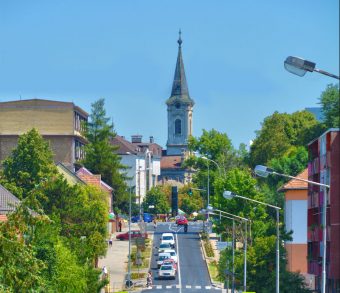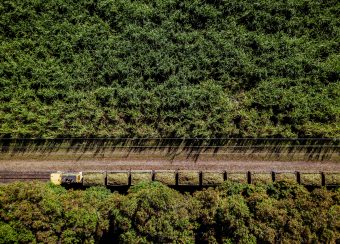
The city is a difficult place for a tree to survive. Compared to their counterparts in the countryside, urban trees generally get less water, suffer more intense heat, compete for space with unyielding infrastructure and frequently become riddled with disease and pests. As a result, many cities are stuck with a lot of dead trees every year.
Cities and private contractors cut them down and usually turn them into firewood, mulch or haul them to the landfill. Often, cities replant fewer trees than they remove, leading to a net loss in canopy cover over time.
However, these trees don’t have to go to waste. “Reforestation hubs” are an exciting model that will save these trees from landfills and instead find new uses for them, such as repurposing for furniture or flooring. This can help cities deal with dead trees while saving money, creating new jobs, addressing long-term public health goals and mitigating climate change at scale.
The urban wood opportunity

Restoring trees to the United States landscape offers big benefits for the climate and communities alike. The scale of the opportunity is staggering: landscapes across the United States alone could support 60 billion new trees. This would sequester up to 540 million tons of CO2 per year — equivalent to replacing 117 million gasoline cars with electric vehicles running on clean electricity. The United States could plant an estimated 400 million of these trees in cities. Capturing this opportunity will take financial resources and concerted effort by a variety of public and private partners.
While waiting for government funding or voluntary private sector finance to kick in at a meaningful scale, cities across the country hold a massive and untapped resource. However, this resource is going to waste — literally.
Every year, 36 million trees come down in cities across the United States due to old age, disease and new development, resulting in economic losses up to $786 million each year. Much of this wood could become valuable products, but instead often gets chipped, thrown in a landfill or burned as firewood. Rethinking urban wood waste could be an unexpected climate and economic solution, turning a burden on the climate and city budgets into a financial engine for reforestation across the broader landscape.
This opportunity is the impetus for the concept of reforestation hubs, pioneered by Cambium Carbon, Cities4Forests and the Arbor Day Foundation, which will be working with city officials to create the nation’s first reforestation hubs by 2022 through a TNC Natural Climate Change Solutions Accelerator Grant.

What is a reforestation hub?
In their simplest form, reforestation hubs are public-private partnerships that save cities money and generate revenue to plant and maintain more trees by diverting downed urban trees from landfills. Instead of going to waste, downed trees are sorted and turned into their highest and best use like furniture, cross-laminated timber, lumber, flooring, compost or mulch. This saves cities money and generates revenue to plant and maintain more trees, building a vibrant circular economy and allowing cities to better combat climate change. In the process, reforestation hubs also support public health and economic growth by creating jobs in green infrastructure through employing people at mills, nurseries and new planting initiatives.
Despite the value urban wood can provide, critical obstacles stand in the way of utilizing them. Cities lack the infrastructure to make fallen trees valuable, and wood product supply chains are not structured around urban wood products. Addressing these two gaps is the first step in creating a functioning reforestation hub. Doing so will require investments in sort yards and mill infrastructure to process incoming wood waste, bringing together city officials, urban millers, artisans, furniture makers, biochar facilities and composting operations. Additionally, it will require building value chains that connect these urban wood ecosystems to the broader market.
More:
Urban wood champions are chipping away at this vision, but with slow progress. Building a reforestation hub requires immense collaboration, and urban wood is a complex raw material to build consistent supply chains around. Reforestation hubs break this log jam by bringing together four ingredients:
1. City-level commitments to divert wood from city agency and contractor operations, buy urban wood for city operations and establish long-term planting plans.
2. Private finance from philanthropic and impact investors for necessary infrastructure.
3. A market incubation platform that drives consumer awareness and leverages technology to connect buyers and sellers.
4. A social impact mission that reinvests profits from the new urban wood economy into tree planting in reforestation hub cities and the surrounding landscapes.
This vision builds on the work of the Baltimore Wood Project, which creates furniture and other high-value products from dead urban trees and reclaimed lumber from houses facing demolition. Baltimore created a network of suppliers and buyers of reclaimed lumber and invested heavily in Camp Small, a sort yard that can process their existing waste stream and turn it into value.
Growing new opportunities for city trees

Reforestation hubs not only bring value through using dead trees, but by creating a path for planting new trees in cities. This comes with numerous public health benefits, including purifying air and water, helping to reduce respiratory disease and decreasing heat. Trees also increase stormwater retention to ease stress on city sewer systems.
Tree canopy health often follows wealth and racial lines in cities, depriving underserved communities of these benefits. Reforestation hubs, by applying the principles of tree equity, can provide funds to improve tree health and plant more trees that benefit these communities. They can also provide new employment opportunities through the markets created for previously under-utilized urban wood.
Making the most of fallen trees
With the financial strain caused by the COVID-19 pandemic, cities may face pressure to defer tree maintenance and replanting, despite the many benefits urban trees provide. At the same time, well-planned reforestation holds the potential to improve the respiratory health of residents and increased urban tree canopies can help cities meet their climate goals. Reforestation hubs offer a multitude of benefits, building new revenue to help fund tree care and planting as well as providing a path to financing broader tree-work in cities. As a result, reforestation hubs have immense potential to become economic, public health and climate boons for cities in the face of intersecting crises.
United States cities and NGOs looking for assistance in developing a reforestation hub can apply to receive pro-bono assistance by October 30 here. Stay up to date on this exciting work and encourage your city to join the movement here.
Source: World Economic Forum



